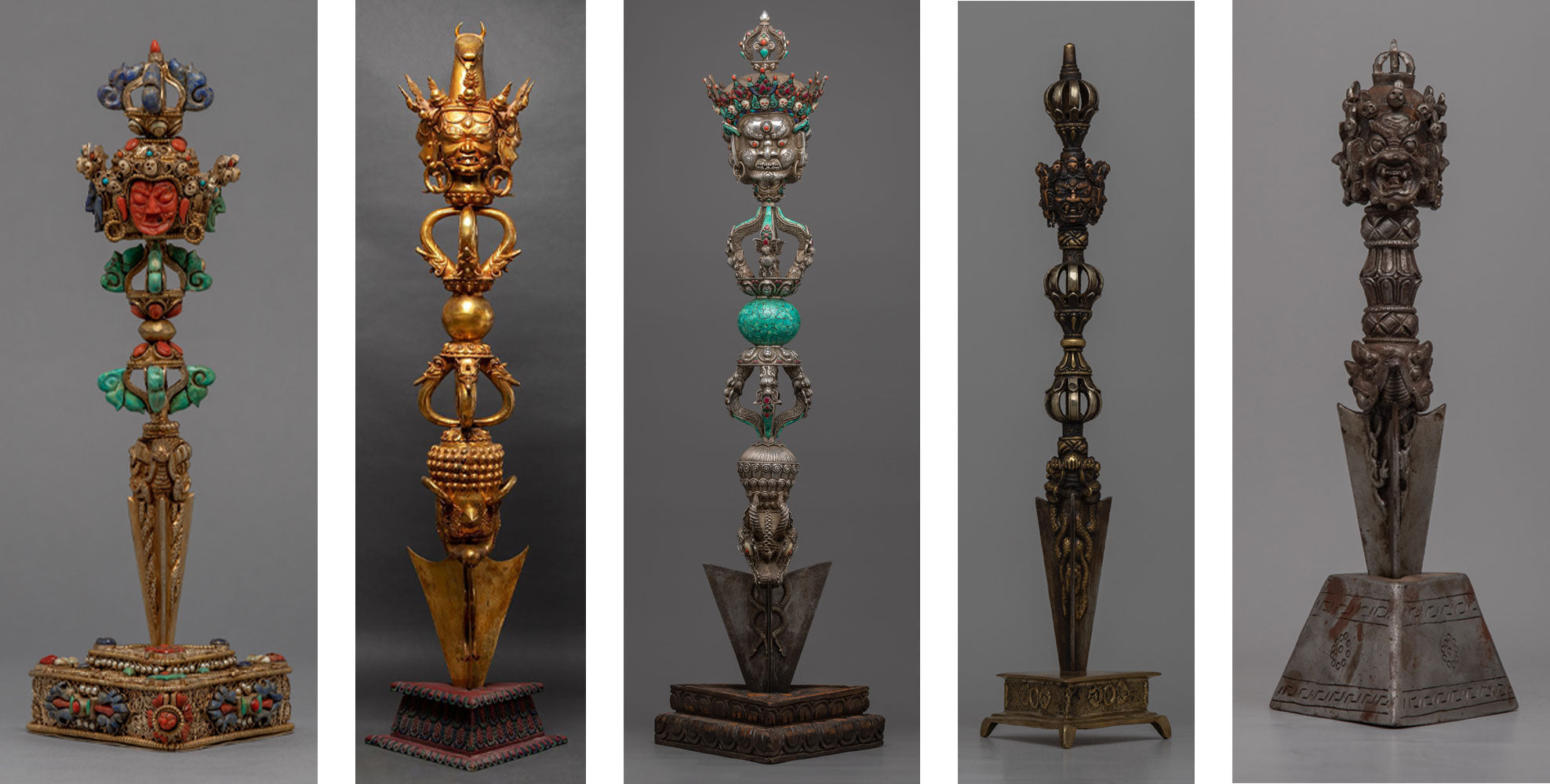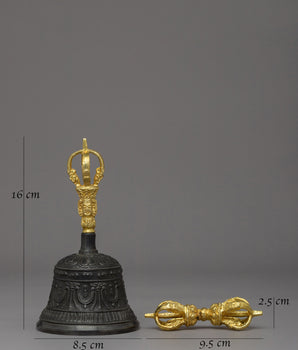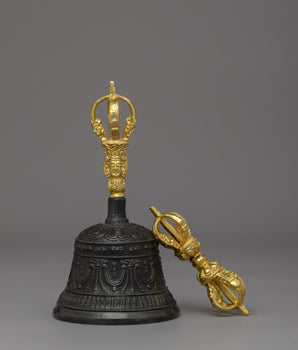The Beauty of Tibetan Purbha: Unveiling Its Spiritual Significance
The Buddhist Phurba, sometimes called "Phurbu" or "Kīla," is a captivating and mysterious ceremonial dagger with profound importance in Tibetan Buddhism and Bon traditions.
This sacred implement, often adorned with intricate artwork and infused with spiritual potency, plays a pivotal role in diverse religious rituals. In this all-encompassing guide, we delve into the historical roots, symbolic meanings, practical applications, and cultural importance of the Tibetan Phurba.
Key Takeaways:
- The Tibetan Phurba, or Phurbu, is a mystical ritual dagger with deep roots in Tibetan Buddhism and Bon traditions.
- It is primarily used to dispel negative energies, defeat inner and outer obstacles, and consecrate sacred spaces.
- The Phurba's design and symbolism are rich with spiritual meaning, including its three-sided blade, tripartite nature, and wrathful deities.
- This ritual dagger is crafted from various materials, such as metal, wood, or bone, and often contains sacred relics.
- The Phurba is a powerful symbol of transformation and a means of harnessing spiritual energy.
History of the Tibetan Phurba
The origins of the Tibetan Phurba harken back to ancient Tibetan shamanism, where it served as an instrument for healing and safeguarding against evil entities. With the proliferation of Buddhism in Tibet, the Phurba seamlessly blended into Buddhist ceremonies, acquiring additional layers of symbolism and significance.
Origins in Bon Tradition
The Tibetan Phurba originates in the Bön religion, a pre-Buddhist spiritual practice in Tibet. In the Bön tradition, similar ritual daggers had been employed for rituals involving exorcism, healing, and safeguarding against evil influences. When Buddhism was introduced to Tibet, the Phurba transformed, assimilating Buddhist symbolism and philosophy into its essence and purpose.
Integration into Tibetan Buddhism

Click here to view our Tibetan Phurba (Ritual Dagger) Collection
Within Tibetan Buddhism, the Phurba is perceived as a potent instrument for quelling negativity and transmuting it into positive forces. Its assimilation into Buddhism is credited to the influence of Padmasambhava, a revered Buddhist master pivotal in introducing Buddhism to Tibet. The Phurba became intricately linked with the wrathful deity Vajrakilaya, a central figure in Tibetan Buddhism.
Historical Significance
Across Tibetan history, the Phurba has been pivotal in religious and spiritual rites. It has been employed in sanctifying sacred places, invoking protective deities, and even as a symbol of divine safeguard in battles. Its historical importance endures, cementing its status as an integral component of Tibetan cultural heritage. Symbolism and Design
The design of the Tibetan Phurba is rich with symbolism, each element holding profound spiritual meaning.
Symbolism and Design
The design of the Tibetan Phurba is laden with symbolism, and its unique features carry profound meanings.
-
The Three-Sided Blade
Its three-sided blade, often made of metal and varying in length, is at the heart of the Phurba's design. This blade design holds several symbolic meanings:
Tripartite Power: The three facets of the blade symbolize the conquest of hindrances and the subduing of adverse influences across three domains: physical, verbal, and mental. This tripartite might is thought to purify one's thoughts, speech, and deeds.
Transformation: The Phurba's three sides serve as emblems of converting ignorance, attachment, and aversion into wisdom, compassion, and detachment, correspondingly. This metamorphosis lies at the heart of the Tibetan Buddhist doctrines.
Piercing Illusion: The keen edges of the blade are emblematic of shooting through delusion and dismantling ignorance, ultimately guiding one toward enlightenment.
-
Tripartite Representation
In addition to its three-sided blade, the Phurba frequently showcases a tripartite depiction at the apex. This representation typically incorporates three countenances or deities, each carrying its unique symbolism:
Vajrakilaya: The central deity depicted is Vajrakilaya, embodying the wrathful facet of compassion. Vajrakilaya is believed to cleanse negative karma, offer protection against hindrances, and guide practitioners towards enlightenment.
Dorje Phurba: Adorning one side of the Phurba's hilt, you may encounter the dorje (vajra) symbol, signifying the unassailable thunderbolt of enlightenment. It symbolizes the strength of realization and the unwavering nature of truth.
Garuda: On the opposing side, the image of Garuda, a mythical bird-like creature, frequently appears. Garuda symbolizes the subjugation of adverse forces and the ability to rise above challenges, liberated from suffering.
Wrathful Deities
Numerous Phurba designs incorporate wrathful deity visages at the hilt or pommel. These deities are revered for their protective qualities against evil forces and their assistance in obliterating internal and external impediments. Including these deities imparts a sense of divine empowerment to the Phurba.
Variations and Materials
Tibetan Phurbas come in various shapes, sizes, and materials, each with unique characteristics and purposes.
Materials
- Metal: Metal Phurbas, frequently fashioned from copper, bronze, or iron, are renowned for their robustness and are a common choice for ritual use, prized for their durability and longevity.
- Wood: While less prevalent, Wooden Phurbas are cherished for their natural and organic texture. They are often intricately carved, adding to their appeal.
- Bone: Bone Phurbas are meticulously crafted from animal bones, often sourced from yaks. They are thought to maintain a profound connection to the spirit world.
Variations
- Dagger-Style: These Phurbas resemble traditional daggers, complete with a handle and blade, and are often employed in ritual insertion into the ground.
- Pendant-Style: Smaller Phurba pendants serve as both jewelry and protective talismans are often carried for personal safety.
- Ceremonial-Style: Elaborate Phurbas, frequently embellished with gemstones and intricate designs take center stage in significant ceremonies and empowerments.
Usage in Rituals
The Tibetan Phurba finds utility in religious rituals and ceremonies, each characterized by its purpose and symbolism. Several typical applications of the Phurba encompass:
-
Dispelling Negative Energies
A crucial role of the Phurba is to eliminate negative energies and evil spirits. In ceremonies referred to as "phurba purifications," the Phurba is driven into the ground or directed toward particular areas where opposing forces are suspected. -
Defeating Inner Obstacles
The Phurba is also harnessed in practices centered on inner transformation. Practitioners often visualize themselves as the Phurba, leveraging its symbolism to overcome personal internal challenges, including ignorance, attachment, and aversion. -
Consecrating Sacred Spaces
Within consecration ceremonies, the Phurba plays a pivotal role in purifying and empowering sacred spaces like temples and stupas. These spaces are consecrated and shielded through the invocation of the Phurba's spiritual energy. -
Transformation and Meditation
The Tibetan Phurba holds a prominent place in transformational practices within Tibetan Buddhism. Meditative techniques involving the Phurba are designed to harness its symbolic potency, facilitating the conversion of negative emotions and thoughts into positive attributes and wisdom.
Practitioners often engage in visualization exercises, portraying themselves as Vajrakilaya or employing the Phurba as a focal point for meditation. This process is thought to assist in purifying the mind and developing inner fortitude, ultimately paving the way to spiritual enlightenment.
Cultural Significance
The Tibetan Phurba carries profound cultural and spiritual importance in Tibet and within Tibetan communities across the globe. It represents a religious artifact and a symbol of resilience and spiritual authority.
-
Protective Amulet
For many Tibetans, the Phurba holds the role of a protective amulet. They adorn themselves with small Phurba pendants or carry miniature versions of the dagger as talismans to shield against negative influences and ensure their well-being. -
Connection to Ancient Traditions
The presence of the Phurba in Tibetan Buddhism establishes a link between modern practices and the ancient Bon traditions of Tibet. It is a testament to the region's rich cultural and spiritual legacy.
The Tibetan Phurba, steeped in a rich history, intricate symbolism, and diverse applications, stands as a testament to the profound spirituality of Tibetan Buddhism and the ancient Bon tradition.
This mystical ritual dagger is a constant reminder of its transformative power, ability to overcome obstacles, and capacity to shield against opposing forces.
Whether employed as a tool for dispelling negativity or embraced as a symbol of personal development, the Phurba maintains its central role in the lives of Tibetans and Buddhists across the globe. Its enduring presence underscores the lasting strength of faith and the deep-rooted significance of cultural heritage in spirituality. Click here to learn more about the other ritual items and its implementation in buddhism.











TASHI DELEK !!!!!